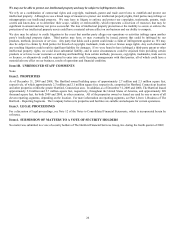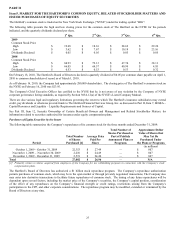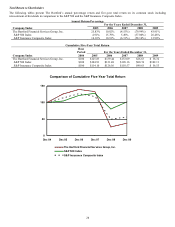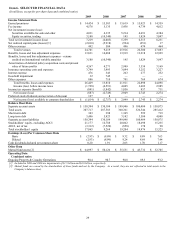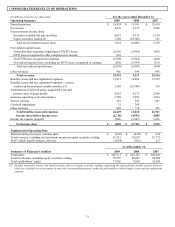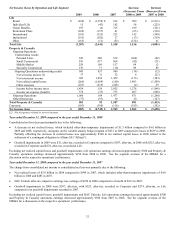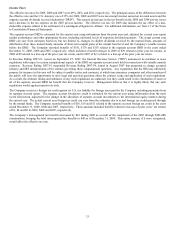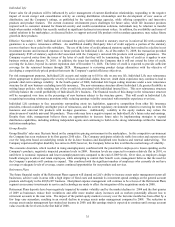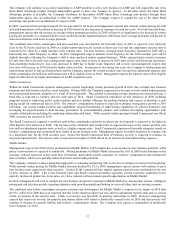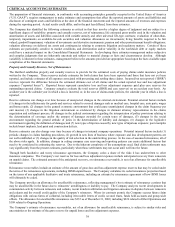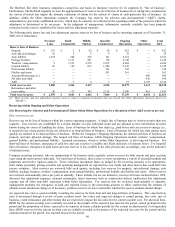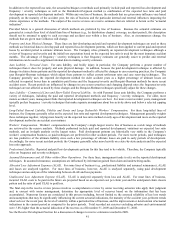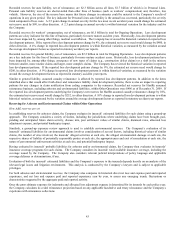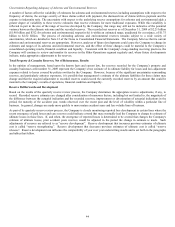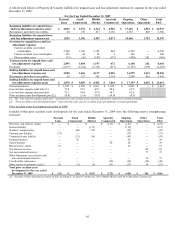The Hartford 2009 Annual Report Download - page 36
Download and view the complete annual report
Please find page 36 of the 2009 The Hartford annual report below. You can navigate through the pages in the report by either clicking on the pages listed below, or by using the keyword search tool below to find specific information within the annual report. 36
International
During the second quarter of 2009, the Company suspended all new sales in International’ s Japan and European operations.
International is currently in the process of restructuring its operations to maximize profitability and capital efficiency while continuing
to focus on risk management and maintaining appropriate service levels.
Profitability depends on the account values of our customers, which are affected by equity, bond and currency markets. Periods of
favorable market performance will increase assets under management and thus increase fee income earned on those assets, while
unfavorable market performance will have the reverse effect. In addition, higher or lower account value levels will generally reduce or
increase, respectively, certain costs for individual annuities to the Company, such as guaranteed minimum death benefits (“GMDB”),
guaranteed minimum income benefits (“GMIB”), guaranteed minimum accumulation benefits (“GMAB”) and GMWB. Prudent
expense management is also an important component of product profitability. During 2009, the Company took actions to realign our
organization and significantly reduce our expense structure which will result in improved earnings over time. The Company continually
evaluates opportunities to mitigate the risks associated with International businesses and manage expenses in order to balance costs and
earnings stability.
Markets partly recovered in the last three quarters of 2009, after a decline in the first quarter, resulting in increased margins in the
second, third, and fourth quarters.
In the fourth quarter of 2009, Hartford Life International, Ltd., an indirect, wholly-owned subsidiary of Hartford Life Insurance
Company, entered into a Share Purchase Agreement with Icatu Holding, S.A, the Company’ s joint venture partner, for the sale of all of
the Company’ s common registered shares and preferred registered shares in Icatu Hartford Seguros S.A, its Brazil operation. The
expected settlement date will be during the first quarter of 2010. The sale of our interests in Icatu Hartford Seguros S.A. will allow the
Company to focus on its core U.S. centric businesses and reduce exposure to currency volatility, but will also reduce the expected future
earnings of International.
Institutional
In 2009, the Company decided to exit several businesses that were determined to be outside of the Company’ s core business model.
Several lines – institutional mutual funds, private placement life insurance, income annuities and certain institutional annuities will
continue to be managed for growth. The private placement life insurance industry (including the corporate-owned and bank-owned life
insurance markets) has experienced a slowdown in sales due to, among other things, limited availability of stable value wrap providers.
We believe that the Company's current PPLI assets will experience high persistency, but our ability to grow this business in the future
will be affected by near term market and industry challenges. The remaining businesses, structured settlements, guaranteed investment
products, and most institutional annuities will be managed in conjunction with other businesses that the Company has previously
decided will not be actively marketed or sold.
The net income of this segment depends on Institutional’ s ability to retain assets under management, the relative mix of business, and
net investment spread. Net investment spread, as discussed in Institutional’ s Operating section of this MD&A, has declined year over
year and management expects net investment spread will remain pressured in the intermediate future due to the low level of market
short-term interest rates, increased allocation to lower yielding U.S. Treasuries and short-term investments, and anticipated performance
of limited partnerships and other alternative investments.
Stable value products experienced net outflows in 2009 as a result of contractual maturities and the payments associated with certain
contracts which allow an investor to accelerate principal repayments (after a defined notice period of typically thirteen months), as well
as the Company opting to accelerate the repayment of principal for certain stable value products. A total of $3.9 billion of account value
was paid out on stable value contracts during 2009. The Company has the option to accelerate the repayment of principal for certain
other stable value products and will continue to evaluate calling these contracts on a contract by contract basis based upon the financial
impact to the Company. In addition, the Company may, from time to time, seek to retire or repurchase certain other stable value
products in open market transactions. Such repurchases, if any, will depend on prevailing market conditions, our liquidity requirements,
contractual restrictions and other factors. Institutional will fund these obligations from cash and short-term investments presently held
in its investment portfolios along with projected receipts of earned interest and principal maturities from long-term invested assets.
Property & Casualty
Personal Lines
The Company expects Personal Lines’ written premiums in 2010 will be relatively flat as growth in AARP is expected to be largely
offset by a decline in Agency. The Company expects personal auto written premiums will be relatively flat as the effects of increased
written premiums from the sale of the Company’ s Open Road Advantage product and increased written pricing will likely be offset by
actions to reduce written premiums in certain market segments and territories. The Company expects homeowners’ written premiums
will also be relatively flat as an increase in written pricing and the cross-sell of AARP homeowners’ insurance to auto policyholders will
likely be offset by the effect of rate and underwriting actions to improve profitability.


